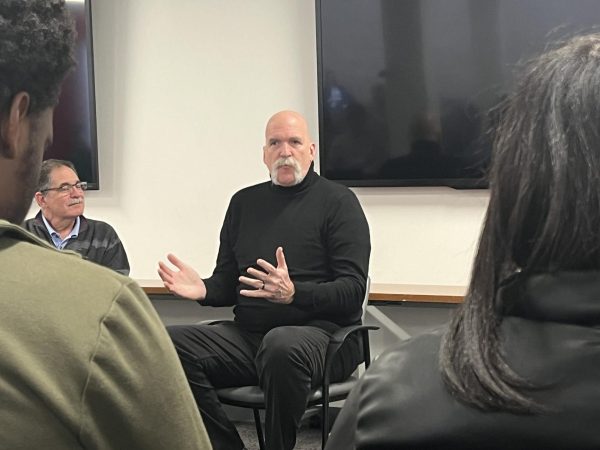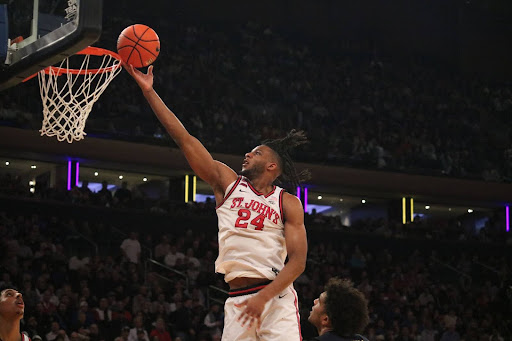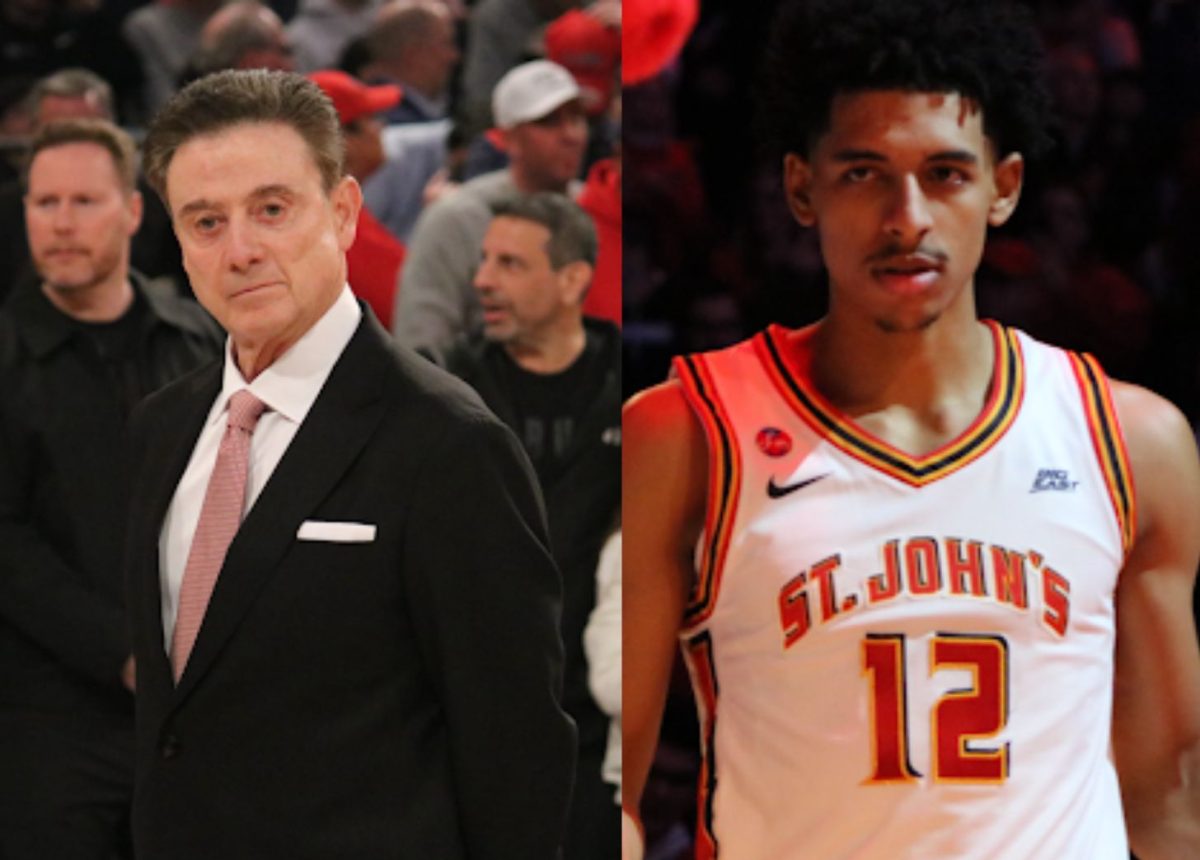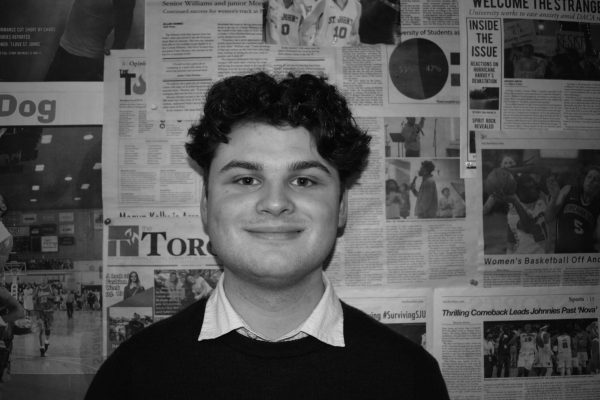
St. John’s University’s journalism department held an invite-only event on April 4 allowing students to interact with former St. John’s basketball player Bill Wennington. Throughout the near hour-and-a-half long panel, Wennington shared life experiences, professional advice and discussed his path from NBA champion to a 20-year career in sports broadcasting.
On a muggy June day in Montreal, Canada, a 16-year-old Wennington was thrown out of his house. His father had taken care of him for the last four years after his mother left the family for another man. Eventually, his father remarried, leading to his dismissal from the home.
“She didn’t like me,” Wennington said, referring to his stepmother.
With nowhere else to turn, the six-foot-five teenager opted for a change of scenery. He made his way to Long Island, NY where his mother took him in. She had since remarried as well, to the very man she left the family for.
“My stepfather, who became like my father, had no money and couldn’t really afford to have me.”
Wennington’s mother and stepfather did not have the financial freedom to send him to a private school, resulting in his enrollment at Long Island Lutheran High School (LuHi) on an athletic-academic scholarship.
It was then that a New York legend was born.
Wennington’s high school coach, five-time state champion Bob McKillop, became a huge influence in his life. Due to the relationship he built with McKillop and his mother’s residency on Long Island, New York began to feel like home for the growing basketball phenom.
After leading LuHi to a top 10 national ranking, he was recruited by famed St. John’s basketball coach Lou Carnesecca, who served as a father figure for the seven-foot eighteen-year-old. Carnesecca, though, wasn’t the only draw for Wennington.
“When you talk about basketball, especially back then, Madison Square Garden. The Mecca of basketball. Being able to play in that building at St. John’s meant a lot.”
And so, the roots for the most successful St. John’s Basketball team in history were planted.
Wennington became the anchor for a starting five that included four future NBA players and back-to-back national players of the year in Chris Mullin and Walter Berry.
All came to fruition in the spring of 1985, when Carnesecca’s impact on Wennington and company resulted in the University’s most recent Final Four appearance in the NCAA Tournament.
The Johnnies’ success catapulted Wennington’s draft stock, and after six years in the Empire State, he was on the move again.
As the late NBA Commissioner David Stern made his way to the podium, Wennington’s newfound professional dream was realized.
“With the 16th pick in the 1985 NBA Draft, the Dallas Mavericks select, Bill Wennington, Center, St. John’s University,” Stern announced to the Felt Forum crowd.
During his five-year stint in Dallas, Wennington played alongside NBA legends Rolando Blackman, Mark Agguire and Detlef Schrempf, partaking in multiple playoff runs. Heading into the 1990-91 season, he would be dealt to the Sacramento Kings in exchange for Rodney McCray and draft capital.
Despite being a proven NBA veteran at this point in his career, the move to Sac-Town offered a delayed ‘welcome to the league’ moment for the seven-footer.
“We won one road game all year. The team just kind of coasted along and accepted what was going on. [We] didn’t do much to change anything because we’re in the NBA, we’re here, we made it.”
Following his one year exile with the dysfunctional organization, Wennington accepted an offer to play for Virtus Bologna, an Italian team in the EuroLeague.
“I went to Italy and played for two years,” he said. “And that rejuvenated me. Got my passion back for the game, because the year in Sacramento was tough.”
After his short career overseas, Wennington became a valuable piece to the NBA’s greatest dynasty. In the summer of 1993, he received an invitation to the Chicago Bulls’ training camp. He ultimately made the team, received a month-long contract and turned it into a six year tenure.
Michael Jordan had recently retired following the Bulls’ first three-peat of the 90s, leaving the team in the hands of Scottie Pippen.
“When I first got there, Michael had just retired. But, Scottie brought it back to the St. John’s level of working hard. And that was good because now everyone had to keep up and it forces everyone to work hard.”
Quite the contrary to the year-long experience in Sacramento.
Jordan eventually unretired, and returned to the franchise he had already delivered three titles to.
“When Michael came back a year and a half later, he brought it to a whole different level,” Wennington said. “[Jordan and Pippen] pushed me higher and got me to do even more things than I thought I could do before.”
Following Jordan’s return, the Bulls ripped off yet another three-peat, including the historic 1995-96 season where Chicago tallied a then-NBA record 72 wins en route to their first title since ‘93.
It was here that Wennington made creating connections a major focus. Knowing he was in the twilight of his playing days, he began setting up a second career once he retired.
Wennington was pitched an idea for a segment that would play during games at the United Center, dubbed ‘Wennington’s World.’ He went to malls and shopping centers, interviewing Bulls fans with light-hearted questions. A short episode of ‘Wennington’s World’ premiered during every Chicago home game, leading to the production of 41 episodes. This created a sense of comfort holding the microphone.
Fast forward two decades, and Wennington has now served as the Chicago Bulls’ radio broadcast color-commentator for over 20 years. Alongside play-by-play caller Chuck Swirsky, the two act as the voices of Bulls basketball.
“When you’re working in media, especially television, you have to work with other people. The really important thing in a broadcast for us is chemistry,” he said. “I want people to enjoy the game.”
Wennington urged those in attendance to understand that radio is still a vital part of media.
“A lot of guys feel like [radio] is second-class,” he said. “But, it’s needed. People are at work where they can’t turn on a TV. [TV] has become more entertainment than just a game. Radio is still a game because you want and need to know the score and what’s going on.”
The event concluded with a few words of motivation from the St. John’s icon. Addressing the bunch of journalism majors, communications majors and high school students, Wennington made his message clear.
“Have goals. Have a plan and strive for that plan every day. If you work hard, good things are going to happen. It may not be exactly what you want, but it’ll get you to where you need to go.”









